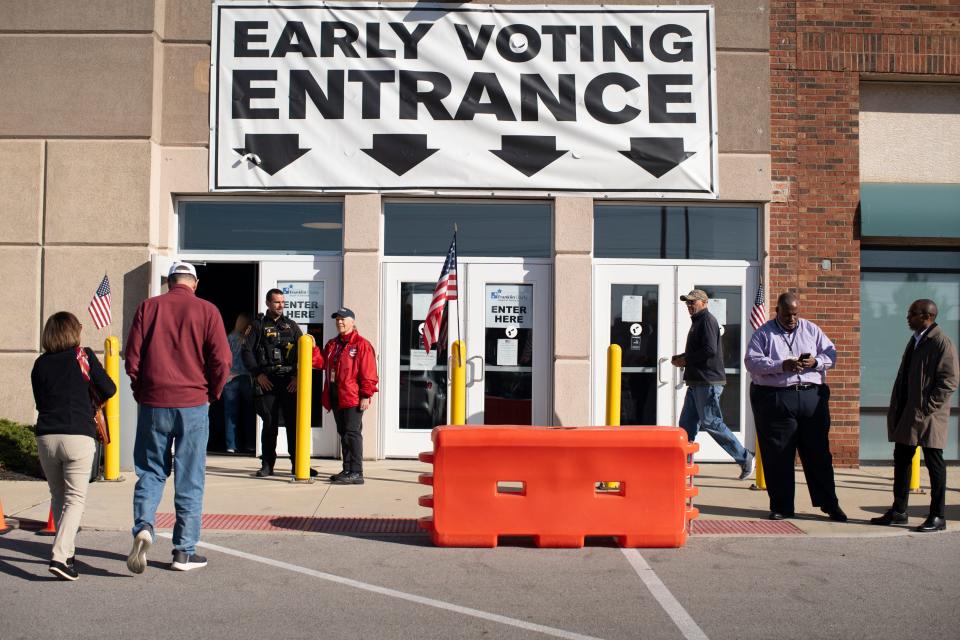Did 'sabotage' work? What new poll says about how Ohioans will vote on abortion amendment.
Robert Alexander is the founding director of the Ohio Northern Institute for Civics and Public Policy. He is a political science professor at Ohio Northern University.
A fight over words ensued shortly after the reproductive rights amendment was approved to go on the Nov. 7 ballot.
The Ohio ballot board approved changes to the summary language in key ways by a 3-2 vote. Among other concerns, advocates were angered that “fetal viability” was changed to “unborn child.”
Likewise, advocates argued that the summary language excluded the amendment’s protections regarding contraceptive care. Others are concerned that the amendment is referred to as Issue 1 at all.
After campaigning for “no” votes on August’s Issue 1, they now find themselves campaigning for “yes” votes on this November’s Issue 1.
Issue elections are very different from typical elections where candidates run under the banner of a political party, hold rallies, and participate in debates. Political parties in particular, serve as an information shortcut for voters. This is largely absent in ballot campaigns, which rely on “issue framing” to a much greater extent.
Robert Alexander: Bellwether no more? Is Ohio's bigly love for Donald Trump proof it lost its swing?
This makes these types of elections much more unpredictable.
Political science research finds that when voters are confused or fatigued by ballot language, they are more likely to vote “no” in an effort to preserve the status quo.
Taken together, pro-choice advocates claim these changes were meant to sabotage the outcome of November’s Issue 1.
Has the so-called 'sabotage' worked? What does our poll tell us?
We were able to test these claims in our recent poll of registered Ohio voters. To do so, we asked half of our respondents about their support with the proposed ballot language and half with the current ballot language facing voters.
While splitting our sample in this fashion increases the margins of error for these specific questions, we find the change in ballot language has an undeniable effect upon levels of support among respondents.
Despite this, we find a majority of Ohioans appear to support Issue 1 regardless of how it is framed to them.

When looking at the current ballot language including “unborn child,” we find 52% who support it, although that number jumps to 68% who support the original ballot language.
Similarly, when we gave respondents the direct choice as to whether they plan to vote “yes” or “no,” we find 60% who say they are voting “yes” on the current ballot language and 69% who say they would vote “yes” with the original ballot language.
Again, the margins of error for these particular questions are between 7-9%, but the pattern is clear–citizens are much more supportive of the original ballot language than the current ballot language.
Republicans and Independents are much less likely to support the current ballot language relative to the original language.
Likewise, support drops considerably among men when comparing the two versions of Issue 1. Democrats and women are far less affected by the change in ballot language.
Eight-seven percent of Democrats support both versions of the ballot language, while 68% of women support the original language and 63% continue to support the current language.
How do Ohioans feel about abortion?
Opponents of Issue 1 have an uphill battle.
Pro-choice advocates have won in every statewide ballot campaign since the Dobbs decision. Public opinion polls have consistently demonstrated strong support for abortion rights in Ohio and in the nation.

Our poll finds 65% of Ohioans agree that abortions should be mostly legal, and 57% who believe Roe v. Wade should not have been overturned.
This support for reproductive rights is consistent with most other polls of Ohio voters taken over the past year. Nationally, 64% of Americans believe abortions should be mostly legal and recent state-wide elections have illustrated that support.
How did we get here?
The Supreme Court’s ruling in the Dobbs decision overturned Roe v. Wade and pushed abortion rights to the states.
Since then, amendments seeking to protect or restrict abortion rights have appeared in six states and pro-choice forces have come up victorious in each of them–including Republican leaning states such as Kentucky, Kansas, and Montana.
It is now Ohio’s turn to determine abortion rights and the nation is watching.
The stakes regarding Issue 1 are high as Ohio’s so-called “Heartbeat law” remains in flux.
The law offered no exception for incest or rape and criminalized nearly every Ohio abortion when cardiac activity is detected – typically around six-week.
It has been held up in Court and Ohio’s Supreme Court is likely to rule on the case pending the outcome of Issue 1.
In an attempt to thwart Issue 1, Gov. Mike DeWine recently signaled he would be open to more exceptions to the bill if the amendment does not pass.
Ohio Issue 1: Issue 1 opponents want Ohio to have the most extreme abortion ban in US. Don't let them.
The road to this November’s ballot has been a winding one to say the least. Once it became clear that abortion rights advocates were seeking to place an amendment on the ballot, the Ohio legislature voted to permit a special legislation in August after essentially prohibiting them earlier in the year.
This resulted in the August special election that sought to raise thresholds making amending the constitution at the ballot box much more difficult. Many recognized August’s Issue 1 as an attempt to prevent this November’s Issue 1 from reaching the ballot.
Ohioans turned out in high numbers and defeated the measure by a resounding margin 57% to 43%.
Soon after the election, the reproductive rights amendment was approved to go before the state ballot board.

It is now Ohioans’ turn to decide the fate of abortion rights in the state. While the road to the ballot box has been full of twists and turns, it will be citizens, not legislators, executive officials, courts, or polls that will determine the outcome on Nov. 7.
The choice is ours and the country is watching, so be sure to exercise your right to vote next week.
Robert Alexander is the founding director of the Ohio Northern Institute for Civics and Public Policy. He is a political science professor at Ohio Northern University.
This article originally appeared on The Columbus Dispatch: What does Issue 1 say? Abortion language poll may offer election clues

